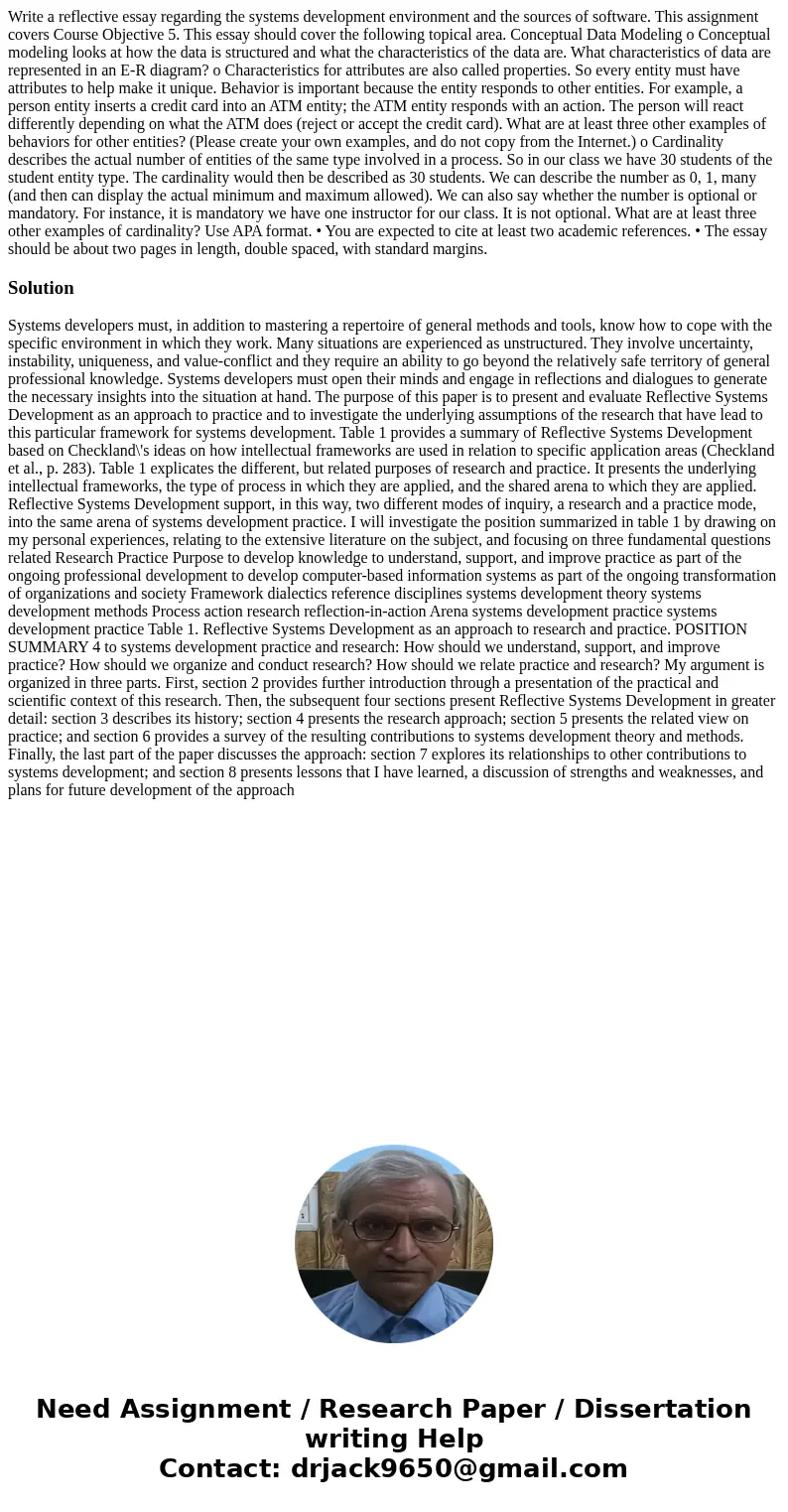Write a reflective essay regarding the systems development e
Write a reflective essay regarding the systems development environment and the sources of software. This assignment covers Course Objective 5. This essay should cover the following topical area. Conceptual Data Modeling o Conceptual modeling looks at how the data is structured and what the characteristics of the data are. What characteristics of data are represented in an E-R diagram? o Characteristics for attributes are also called properties. So every entity must have attributes to help make it unique. Behavior is important because the entity responds to other entities. For example, a person entity inserts a credit card into an ATM entity; the ATM entity responds with an action. The person will react differently depending on what the ATM does (reject or accept the credit card). What are at least three other examples of behaviors for other entities? (Please create your own examples, and do not copy from the Internet.) o Cardinality describes the actual number of entities of the same type involved in a process. So in our class we have 30 students of the student entity type. The cardinality would then be described as 30 students. We can describe the number as 0, 1, many (and then can display the actual minimum and maximum allowed). We can also say whether the number is optional or mandatory. For instance, it is mandatory we have one instructor for our class. It is not optional. What are at least three other examples of cardinality? Use APA format. • You are expected to cite at least two academic references. • The essay should be about two pages in length, double spaced, with standard margins.
Solution
Systems developers must, in addition to mastering a repertoire of general methods and tools, know how to cope with the specific environment in which they work. Many situations are experienced as unstructured. They involve uncertainty, instability, uniqueness, and value-conflict and they require an ability to go beyond the relatively safe territory of general professional knowledge. Systems developers must open their minds and engage in reflections and dialogues to generate the necessary insights into the situation at hand. The purpose of this paper is to present and evaluate Reflective Systems Development as an approach to practice and to investigate the underlying assumptions of the research that have lead to this particular framework for systems development. Table 1 provides a summary of Reflective Systems Development based on Checkland\'s ideas on how intellectual frameworks are used in relation to specific application areas (Checkland et al., p. 283). Table 1 explicates the different, but related purposes of research and practice. It presents the underlying intellectual frameworks, the type of process in which they are applied, and the shared arena to which they are applied. Reflective Systems Development support, in this way, two different modes of inquiry, a research and a practice mode, into the same arena of systems development practice. I will investigate the position summarized in table 1 by drawing on my personal experiences, relating to the extensive literature on the subject, and focusing on three fundamental questions related Research Practice Purpose to develop knowledge to understand, support, and improve practice as part of the ongoing professional development to develop computer-based information systems as part of the ongoing transformation of organizations and society Framework dialectics reference disciplines systems development theory systems development methods Process action research reflection-in-action Arena systems development practice systems development practice Table 1. Reflective Systems Development as an approach to research and practice. POSITION SUMMARY 4 to systems development practice and research: How should we understand, support, and improve practice? How should we organize and conduct research? How should we relate practice and research? My argument is organized in three parts. First, section 2 provides further introduction through a presentation of the practical and scientific context of this research. Then, the subsequent four sections present Reflective Systems Development in greater detail: section 3 describes its history; section 4 presents the research approach; section 5 presents the related view on practice; and section 6 provides a survey of the resulting contributions to systems development theory and methods. Finally, the last part of the paper discusses the approach: section 7 explores its relationships to other contributions to systems development; and section 8 presents lessons that I have learned, a discussion of strengths and weaknesses, and plans for future development of the approach

 Homework Sourse
Homework Sourse